Driving in California can be frustrating — research shows that drivers in Los Angeles County spent an average of 61 hours sitting in traffic in 2021. The state is legendary for its congested roadways. But what happens when normal frustration behind the wheel spirals out of control?
“Road rage” is a term coined by media outlets in the 1980s. While there isn’t an exact legal definition of road rage, engaging in road rage behaviors in California can still land you in legal trouble. What is road rage, how does it differ from aggressive driving, and how can you best protect yourself and others on the road? Read on to learn more.
What Is Road Rage?
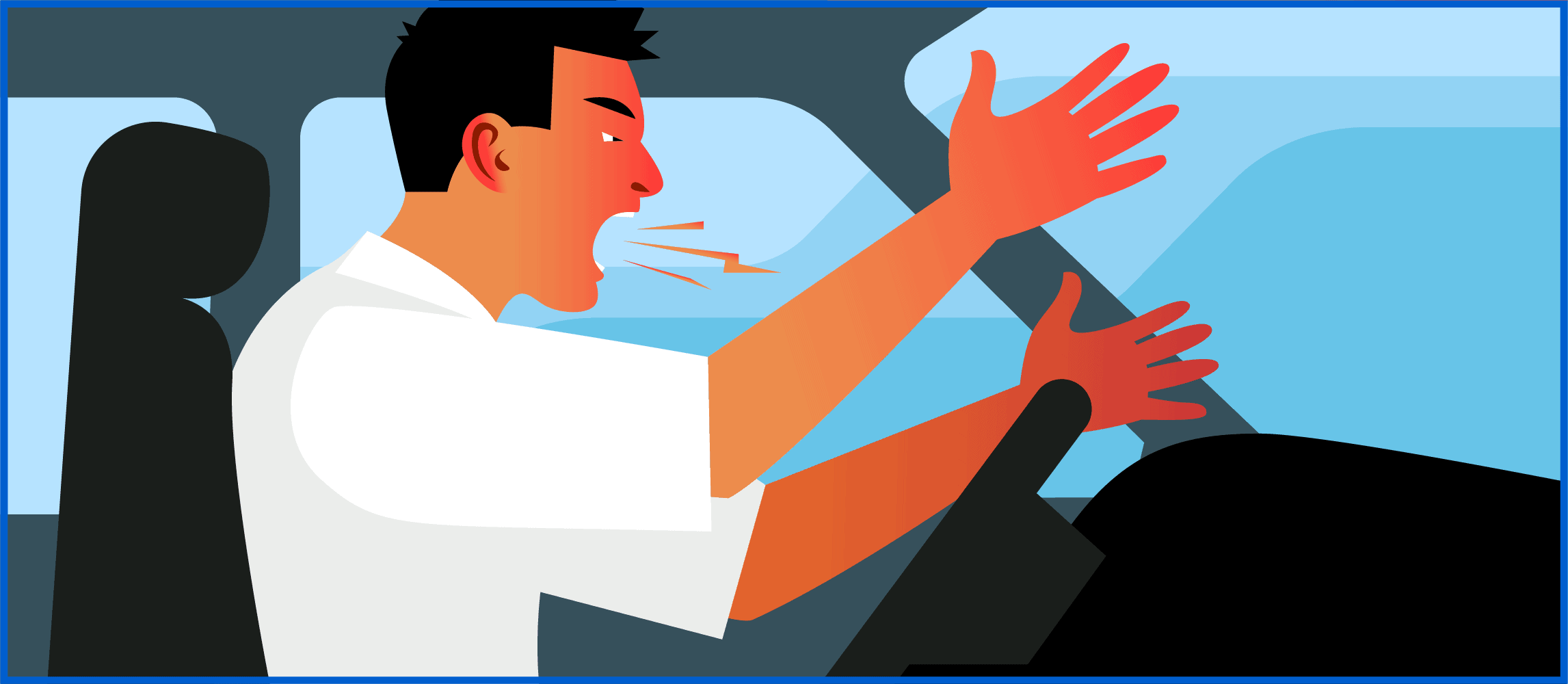
The term “road rage” seems to have originated in Los Angeles, after it was used by local news station KTLA to describe a string of shootings that occurred on state freeways during the summer of 1987. The term was catchy, and it caught on nationwide. But what does road rage actually mean?
Contrary to popular belief, “road rage” isn’t a legal term. The National Highway Traffic Safety Administration defines it as when a driver “commits moving traffic offenses so as to endanger other persons or property; an assault with a motor vehicle or other dangerous weapon by the operator or passenger of one motor vehicle on the operator or passengers of another motor vehicle.”
In other words, road rage is when a driver threatens another person’s life, safety, or property, or uses a vehicle as a weapon to cause harm against another person or their property.
Traffic school can help you keep a clean driving record, prevent insurance increases, and more!
Examples of Road Rage
There are many ways that road rage can manifest. Some examples include:
- Running red lights or attempting to “beat” red lights.
- Changing lanes and passing dangerously and/or without signaling; this may involve a lot of swerving.
- Tailgating another vehicle, or driving dangerously close to the vehicle in front of your own in order to intimidate the driver.
- Driving at a speed much higher than the speed limit.
- Flashing your headlights or brights at the driver in front of your car when you feel that they are driving too slowly.
- Honking your horn often, especially to express anger or impatience with others’ driving behaviors, rather than as a reasonable warning to another driver.
- Screaming and yelling at other drivers, using obscene gestures, or expressing overt anger toward other drivers.
- Throwing objects at other drivers or vehicles.
- Using your vehicle to ram other vehicles or property.
- Forcing another driver off the road.
- Following another driver after a perceived wrongdoing.
In the worst cases, road rage can involve physical violence; for example, shooting at other drivers, as in the Los Angeles cases mentioned above.
Common Behaviors That Can Lead to Road Rage
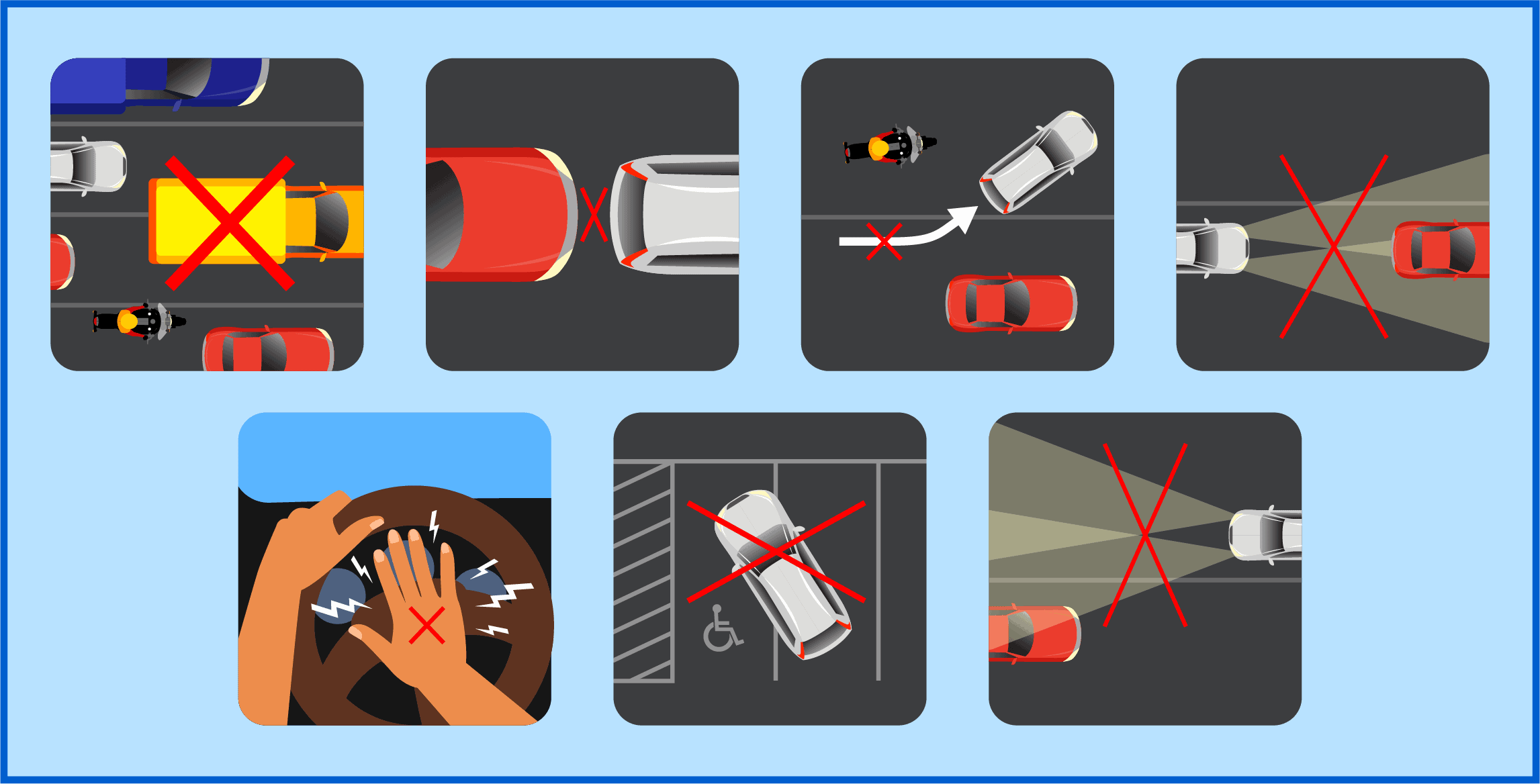
When dealing with other drivers who are prone to road rage, experts identify a number of behaviors that can cause them to react aggressively. These include:
- Lane blocking, or blocking other drivers from using the far left lane to pass slower vehicles on a highway.
- Tailgating, or following the vehicle ahead of you too closely.
- Turning or changing lanes without using a signal.
- Honking your horn unnecessarily, especially if other drivers might interpret that as you honking at them.
- Using up more than one parking space.
- Using your high-beam headlights when facing oncoming traffic or approaching another vehicle from behind.
Some other commonly cited reasons for road rage include:

- Heavy traffic. Especially in California’s most congested driving areas, the impatience that can accompany sitting in traffic can cause road rage behaviors.
- Anonymity. Some people believe that when driving, you can interact with other drivers and never see them again. This emboldens some drivers to engage in behaviors they wouldn’t if someone they knew was watching.
- Distracted driving. When drivers are distracted, it can cause them to swerve, run red lights, and cut off other drivers. These behaviors can be frustrating to witness, and that frustration can lead to road rage.
However, it’s important to note that if another driver engages in road rage behaviors, that is their responsibility, regardless of the behaviors of other drivers around them. While one driver inadvertently breaking a traffic law may set off another driver’s road rage, the only person responsible for the road rage is the driver who is acting on it.
Road Rage vs. Aggressive Driving
In California, the Vehicle Code makes it a crime to drive recklessly or aggressively, which is defined as, “drive a vehicle upon a highway in willful or wanton disregard for the safety of persons or property.” Courts can consider driving behaviors like speeding, swerving, and tailgating to determine whether they constitute reckless or aggressive driving on a case-by-case basis.
While many of these behaviors overlap with road rage behaviors, there’s no legal definition of “road rage” that makes it a crime. However, road rage behaviors can result in reckless or aggressive driving charges, which are typically misdemeanor charges. And in cases where a driver with road rage threatens or causes harm to another person or their property, criminal charges for assault, assault with a deadly weapon, or battery may be considered.
What Causes Road Rage?

Road rage is more common than you may think. One study estimates that more than half of drivers have felt road rage at some point — though not all of them act on those feelings. Still, aggressive driving is the cause of thousands of vehicle crashes each year. One study found that a “typical” road rager who acts on feelings of rage has done so at least 27 times.
“Road ragers are selfish, power hungry, angry, and vindictive,” psychologist Ava Cadell, PhD, told WebMD. She added that in addition to being violent behind the wheel, road ragers are likely to act violently in other areas of their life, like with their family.
Psychotherapist Ana Jovanovic added in an interview with NBC News that “the initial turn [in our mood] usually has nothing to do with the traffic. We can be feeling upset over something that happened at work, or with a friend or a partner. The ‘turn’ we make is allowing angry thoughts to occupy our minds [such that it] infiltrates into the very thing we are doing at that moment, even if that thing — such as driving — has nothing to do with the reason for our anger.”
In other news, having feelings of road rage isn’t necessarily the problem. It’s when a driver decides to act on those feelings that road rage becomes dangerous and potentially criminal.
Road Rage Statistics in 2023
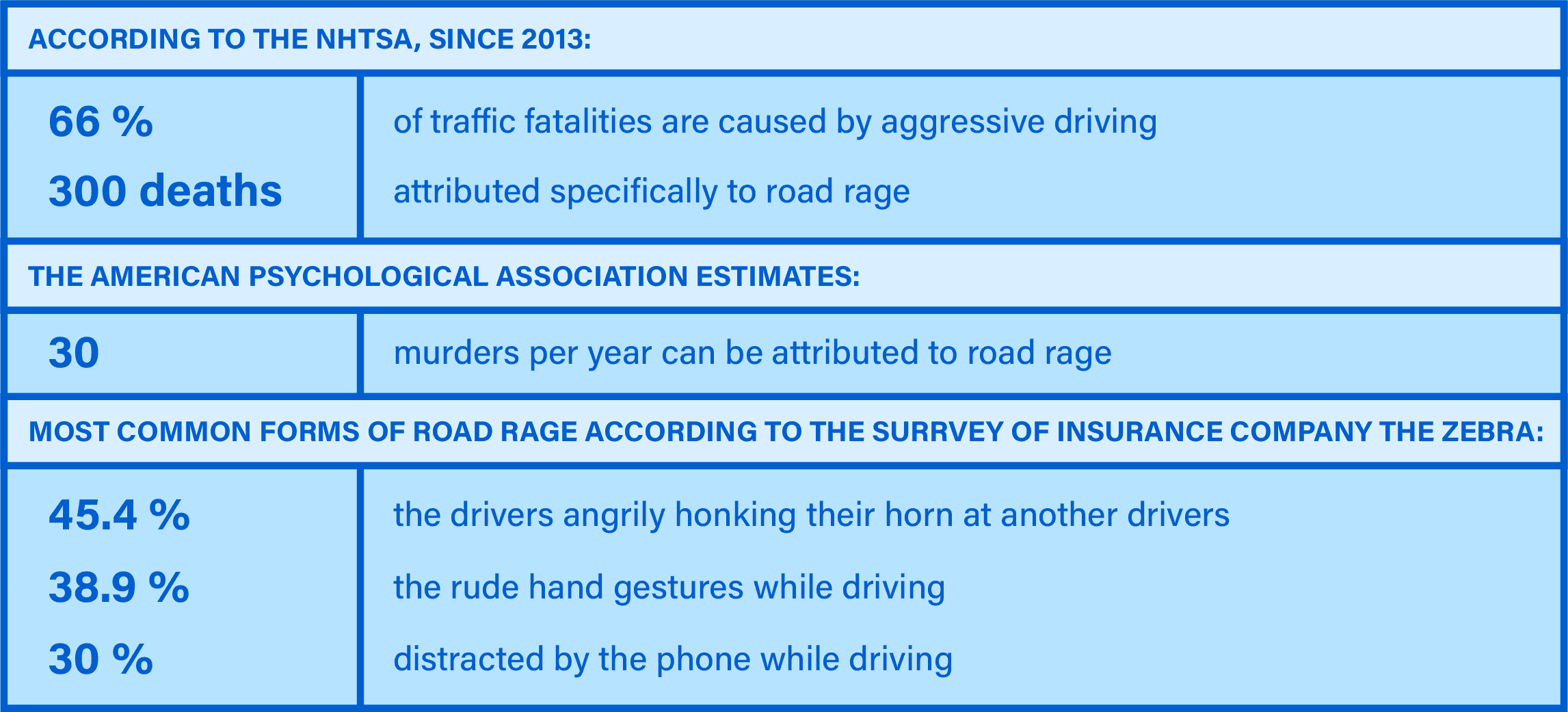
According to the NHTSA, 66 percent of traffic fatalities are caused by aggressive driving. And since 2013, 300 deaths have been attributed specifically to road rage.
The American Psychological Association estimates that an average of 30 murders per year can be attributed to road rage. They also found that more than half of drivers respond to perceived aggression from other drivers by becoming aggressive themselves.
Auto insurance company The Zebra surveyed 1,500 American drivers about aggressive driving and road rage and found that:
- One driver angrily honking their horn at another driver was the most common form of road rage they had witnessed. 45.4 percent said they had seen this behavior take place.
- Second most common was using rude hand gestures while driving — 38.9 percent of the drivers surveyed said they had witnessed this behavior.
- The largest share of the drivers surveyed (30 percent) said that the most frustrating thing another driver can do is be distracted by their phone while behind the wheel.
How to Respond to Road Rage
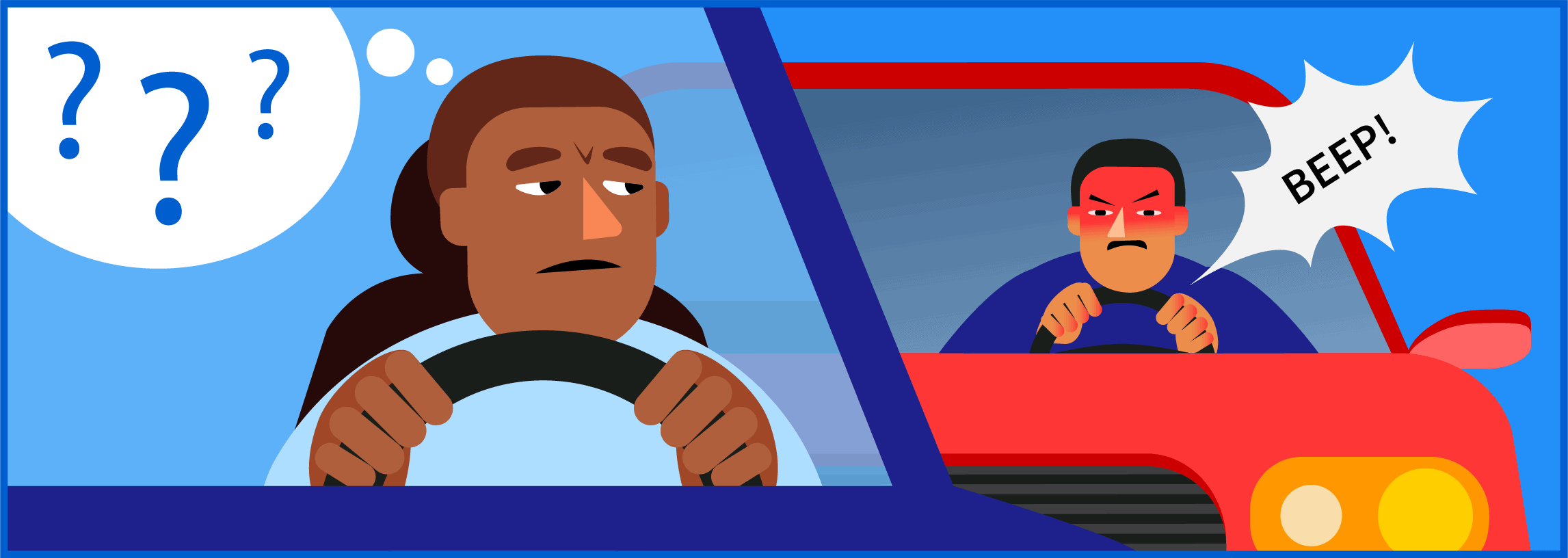
If you see another driver engaging in road rage behaviors, there are some things you can do to deescalate the situation and keep yourself and other drivers as safe as possible.
- Stay calm. Try not to retaliate or do anything that might provoke the other driver, like yelling, making rude gestures, or blocking them with your vehicle. Avoid making eye contact, which can also be seen as aggressive.
- If you’re being tailgated by an aggressive driver, change lanes to encourage them to pass you. If someone is trying to pass you, slow down so they can do so quickly and easily.
- Keep your distance. Any time you see another driver behaving erratically or dangerously, it’s a good idea to try to stay away from them. Don’t speed, weave through traffic, or drive dangerously yourself, but try to safely put some distance between yourself and the other driver.
- Stay behind them. An aggressive driver is less dangerous when they’re in front of you.
- Don’t stop. This could be interpreted as an invitation for the other driver to stop too, and confront you.
- If you are confronted, remain calm and courteous.
- Pull into the nearest police station or call 911 if you need help.
Do You Have Road Rage?

It’s perfectly normal to experience feelings of frustration or even anger occasionally while behind the wheel. But drivers with road rage have a hard time letting go of those feelings, and sometimes act on them in dangerous or violent ways. To assess your own driving and whether you engage in road behavior, ask yourself the following questions:
- Do you pass other vehicles in the right lane?
- Do you block the passing lane so it’s more difficult for other drivers to get around you?
- Do you tailgate other vehicles when you think they’re driving too slow or making other errors?
- Do you keep your high-beams turned on when approaching oncoming vehicles or approaching other vehicles from behind?
- Do you roll through stop signs?
- Do you run red lights?
- Do you race through intersections, even when pedestrians are present?
- Do you drive above the speed limit on a regular basis?
- Do you turn or change lanes without using a turn signal?
- Do you frequently use your horn, even when it’s not an emergency?
- Do you flash your headlights at other drivers?
- Do you yell or make rude gestures at other drivers?
If you answered yes to any of these questions, it’s not guaranteed that you have a problem with dangerous, reckless, or aggressive driving, or road rage. But if you answered yes to any of the above questions, you may want to examine your driving behavior and review the rules of the road to ensure you’re driving in a way that keeps you and others as safe as possible.
How to Minimize Your Road Rage
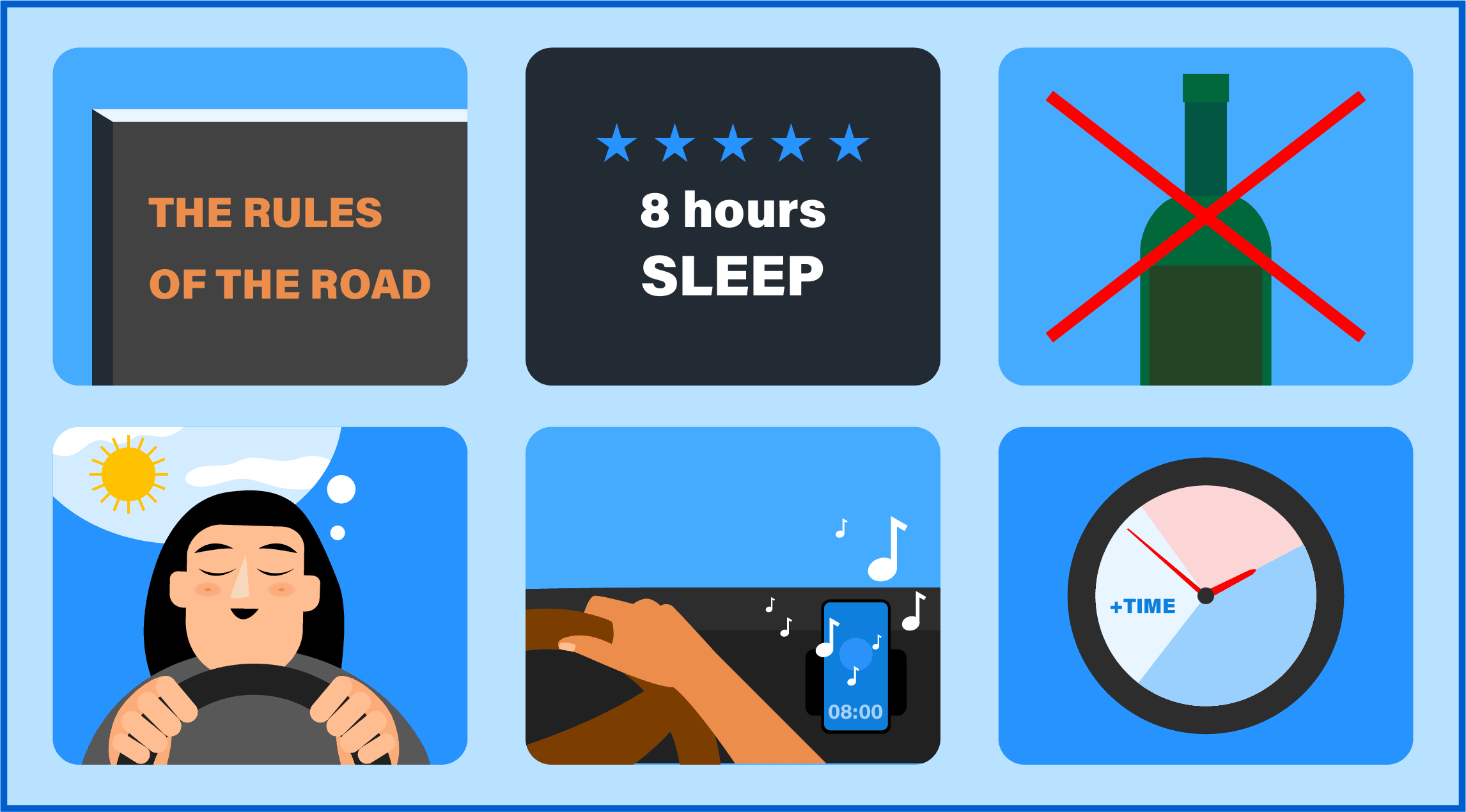
If you’re worried about your own road rage behaviors, try these steps to minimize road rage every time you’re behind the wheel.
- Follow the rules of the road. Stay up to date on traffic laws and do your best to follow all of them at all times.
- Get enough sleep. Being tired can make you more impatient and irritable, leading to road rage.
- Limit alcohol. In addition to the dangerous effects alcohol can have on your driving abilities, it can also make you more tired, short-tempered, erratic, and unpredictable — all of which can lead to road rage.
- Leave on time. Give yourself plenty of time to arrive to your destination, even if you hit traffic or encounter any unplanned hazards or delays. That way, you’re less likely to be impatient, frustrated, or frazzled because you’re running late.
- Cool down before driving. If you’re feeling angry, sad, or emotional, don’t go for a drive to cool down. Instead, try to regulate your emotional state before you get behind the wheel. Only drive when you are feeling calm.
- Play soothing music or podcasts.
- Give other drivers the benefit of the doubt. If someone breaks a traffic law near you, don’t take it personally. Instead, try to practice empathy and consider that maybe they needed to maneuver to account for someone else’s mistake, to avoid a hazard, or because they simply made an honest mistake.
- Be aware of negative patterns. Pay attention to your emotions and driving behaviors and look out for negative patterns. For example, if you’re more likely to drive ragefully after a hard day at work, look for ways you can calm down and regulate your emotions after getting off work, but before getting behind the wheel.
- Keep a photo of your loved ones on the dash. Remind yourself to drive safely so you can always return home to them. And act like their picture is them watching you drive, and don’t engage in any behaviors they wouldn’t approve of.
Road rage is dangerous and all-too-common. But with these tips, you can minimize your own road rage, deescalate other drivers, and keep the roads safer for everyone.
